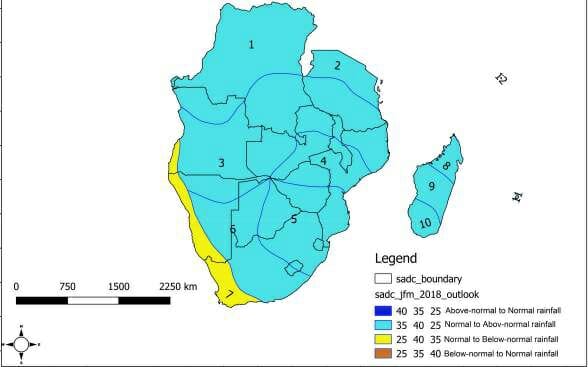
Scientists give above-normal rainfall in 2018 a fair chance

While not overly optimistic, an updated rainfall forecast for southern Africa sees a reasonable chance for a wetter 2018, with the stark exception of the western coastal plain in Angola, Namibia and South Africa.
The consensus rainfall forecast issued on Wednesday by the Southern Africa Regional Climate Outlook Forum in Gaborone, sees a 40% chance for normal to above normal rainfall for Namibia for the duration of the main rain season in January, February and March 2018. It is only the coastal plain below the escarpment where normal to below normal precipitation is expected. The probability for this region is also 40%.
The above normal rainfall zone extends across the Southern African Development Community while the below normal zone extends into the southern Angolan coastal plain and into the Karoo region in South Africa.
For the February, March, April season, rainfall prospects over the northern Namib are expected to improve but it is only in the later March, April, May season that the southern Namib may also receive normal to above normal precipitation. These forecasts, particularly for the southern Namib, must be seen in the context of the area’s natural aridity where any accumulated precipitation above 150 mm ranks as above normal.
The Forum’s midseason precipitation review was done last week by meteorologists from various national meteorological and hydrological services in SADC member states. The final release was formulated by the SADC Climate Services Centre.
Additional input and expert interpretation were acquired from other global climate prediction centres namely, the European Centre for Medium Range Weather Forecast, the National Oceanic and Atmospheric Administration (NOAA) in the United States, the Beijing Climate Centre, Météo-France and the Australian Bureau of Meteorology. Further contributions came from the Famine Early Warning Systems Network, the International Research Institute for Climate and Society, the Korea Meteorological Agency, the Japan Meteorological Agency and the United Kingdom Met Office.
Taking cognisance of current La Nina conditions in the eastern and central Pacific Ocean, the scientists defined rainfall probabilities based on the wettest third of recorded years between 1971 and 2010 to determine above normal expectations, the driest third for below normal rainfall and the middle third for normal rainfall.
The scientists also considered the position of the so-called Inter-Tropical Convergence Zone (ITCZ), the Indian Ocean Dipole and the active phases of the Madden Julian Oscillation index.
The ITCZ they observed as being very active, located south of the equator and present over the DRC and Tanzania. The Indian Ocean Dipole is the difference in atmospheric pressure on the surface between the ocean offshore eastern Africa and the ocean south of Indonesia. This dynamic mechanism drives the so-called Indian Ocean Transport which constitutes the main route for moisture to enter central Africa from the Indian Ocean from where it is typically advected into Angola and from there into Namibia.
At this point, the Indian Ocean Dipole is neutral but the scientists expect it to develop a weak positive trend (plus 1 standard deviation) as the monsoon system shifts into the southern hemisphere north and east of the Seychelles.
The scientists noted that during October and November this year, rainfall in the DRC, Tanzania, northern Zambia and northern Mozambique, was above normal while most of Angola, Western Zambia, Botswana, Namibia and South Africa’s Karoo region, received below normal rainfall.

Rainfall probabilities for February, March and April 2018










































